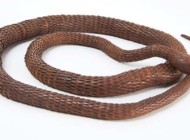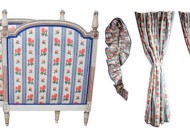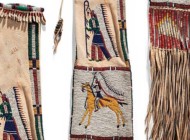
The top selling lot of the day was this oil painting of the Grand Canyon by Gunnar Widforss. The artist, known for his Grand Canyon paintings, lived on the South Rim for several years, and the painting realized $27,600.
Review and Onsite Photos by Rick Russack, Catalog Photos Courtesy William A. Smith Inc.
PLAINFIELD, N.H. — Bill Smith’s Labor Day combined good furniture, fine jewelry, paintings, Oriental rugs, decorative accessories, Asian antiques, vintage motorcycles and some one-of-a kind items. In the latter category was one of the oldest items to be sold recently at a New Hampshire auction — a mastodon tusk. There were also several pieces of furniture made by Donald Dunlap, including a very fine three-piece secretary/desk. Prices were strong and, as always, there were bargains to be had. Smith does not utilize internet bidding. “I hate it, it’s ruining our business,” he said, but he had a standing-room-only crowd, and several phone lines were active throughout the sale.
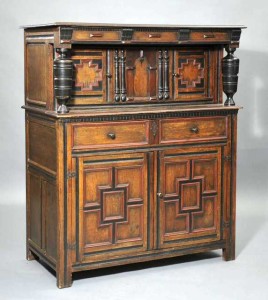
The sale included several pieces of early furniture, and this restored oak, maple and pine court cupboard, probably made in Cambridge, Mass., was the top selling piece, earning $18,400.
The top lot of the 500-lot sale, finishing at $26,400, was an oil painting of the Grand Canyon, by Gunnar Widforss (1879–1934). A website devoted to the artist’s work declares, “Widforss may be the Grand Canyon painter par excellence” and for some years, in the 1920s, he lived at the South Rim of the canyon, trading his paintings with the Fred Harvey Company for a room in one of their employee dormitories and meals. A book on the artist, Gunnar Widforss, Painter of the Grand Canyon was published in 1969. Another painting that did well was “Maternidad” by Eduardo Kingman (1913–1997), considered by some to be one of Ecuador’s greatest Twentieth Century painters. The painting of a mother and child earned $18,400, a relatively strong price for the artist.
A painting by Rockport School artist Anthony Thieme (1888–1954) realized $14,950. The colorful, impressionistic painting, perhaps a Cape Ann scene, was titled “Lonesome Quarry” and depicted a steeply-sided granite quarry, with reflections in a pool of water. The artist, who committed suicide in 1954, was one of the foremost members of the Rockport School. Another painting by a member of the Rockport School, Aldro Hibbard (1886–1972), “Country Church #5,” finished at $8,050. An attractive oil by one of the lesser-known White Mountain artists John W.A. Scott (1815–1907), realized $7,360. It was a landscape with trees in autumn colors and a mountain that might have been Mt Chocorua in the background.
Perhaps one of the oldest things sold in New Hampshire recently was a mounted, 43-inch mastodon tusk, which sold for $9,430 to a buyer who left immediately after making the purchase. When asked how old the tusk might be, he answered, “anywhere from 10,000 years to 30 million years. Mastodons have been extinct for more than 10,000 years.” There are conflicting theories as to why they disappeared from North America.
Smith’s Memorial Day sale last year included several pieces of furniture made by Donald Dunlap, a descendant of New Hampshire’s Dunlap family of cabinetmakers and one of the premier furniture craftsmen of the Twentieth Century. That sale comprised Dunlap’s personal collection. This sale included about a half dozen pieces made by Dunlap, consigned by a collector who was about to relocate to the West Coast. Greg Thulander and his wife, who are restoring a house in Hampstead, N.H., bought an outstanding tiger maple three-part secretary/desk, with several carved fans, carved skirt and a lattice work crest. They paid $13,800 for the piece, which was far less than a similar piece brought last year. The couple also bought Dunlap’s Queen Anne tiger maple highboy with a fan carved apron, paying $5,175. They said they had bought some of the Dunlap pieces at last year’s sale.

“Lonesome Quarry” by Rockport School painter Anthony Thieme earned $14,950. The colorful scene may have been on Cape Ann.
Early in the sale, Smith sold an important banjo clock with a painted dial signed by the Roxbury, Mass., clockmaker, William Cummens. According to John Delaney, Cummens, who died in 1834, was trained by Simon Willard, and throughout his life, maintained a good-working relationship with Willard. Working in Roxbury, Cummens had direct access to the same suppliers, case makers and dial painters that the Willards used. As a result, his clocks are very similar in form to Willards. This clock included its original shipping case and earned $7,475. A Federal tall case clock by Hopkinton, N.H., clockmaker, P. Brown, sold for a little less, reaching $7,188, and another Federal tall case clock, with a dial signed Aaron Willard, fetched $8,050. It had been found in a Connecticut attic, along with some of the other clocks in this sale. However, the top selling clock of the day was an elaborately carved Black Forest tall case clock with three carved bears, which ended up at $17,250.
There were a number of pieces of early furniture. An important but restored court cupboard, in oak, maple and pine, illustrated in Bob Trent’s An Early Cupboard Fragment From The Harvard College Joinery Tradition drew several phone bidders competing with a bidder in the room. It went to one of the phone bidders for $18,400. Smith dated a stool with boldly turned legs to 1730–50. It retained old color and went for $4,888. A two-drawer “sunflower” lift top chest, made of oak and pine, cataloged as Connecticut pilgrim century, achieved $5,980. A large gate leg dining table with bold Spanish feet and a drawer, attributed to the workshop of New Hampshire cabinetmaker John Gaines, sold for $5,175, although there was some restoration to two of the eight feet.
One of the five vintage motorcycles in the sale, a 1961 Enfield Constellation 700cc bike, went to a buyer in the room who said he has four vintage bikes and plans to ride this one. He paid $4,140. Each of the five bikes had been restored and all came from one collection. A 1959 BSA A-10 Golden Flash, 650cc bike, with paperwork, achieved $4,600, and a 1974 Triumph Trident (T150V) went for $4,140.
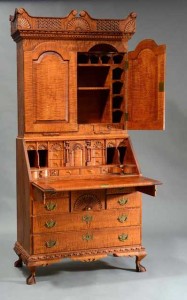
The catalog called this tiger maple secretary made by Donald Dunlap “spectacular,” and it was. The interior had seven carved fans, the typical Dunlap lattice work crest and a carved skirt. It sold for $13,800 to collectors from Hampstead, N.H., who have several other pieces of furniture by Dunlap.
Bill Smith said he likes selling good jewelry and he had several pieces. A diamond straight-line tennis bracelet, with a total weight of ten carats of diamonds, set in platinum weighing 31 grams, was one of the stars of the category, finishing at $12,075. Also doing well was a pair of diamond and jade earrings set in platinum. EGL certified as natural, untreated jade, 22.8 carats, the pair earned $10,350. A very colorful Mughal necklace and matching earrings in their original box, circa 1900, enameled with rubies, sapphires and pearls, realized $5,265. An Art Deco diamond and sapphire bracelet set in platinum with 2½ carats of diamonds achieved $4,888. As he was selling this piece, Smith said, “I love selling classy jewelry like this — could do it all day long.”
You rarely see an auctioneer discouraging bids but that’s what happened with a pair of Chinese jars, cataloged as “Nineteenth Century Chinese covered jars, one with a minor repair.” Prior to the auction, Jeff Waddell, who deals in and restores ceramics, said that the catalog description was incorrect, and the jars were from the Eighteenth Century and very fine. Bidding started low but proceeded in $200 increments to $7,200 ($8,280 with the buyer’s premium). The eventual buyer, in the room, competing with a phone bidder, held his paddle up continuously, and Smith became concerned if both buyers knew there was damage. He kept asking, “Does the phone bidder know about the damage?” and asked the same thing of the bidder in the room. As the bidding progressed, he made it clear to both bidders that the jars could not be returned because of condition issues, etc. He appeared relieved when the bidding finally ended, much to the entertainment of the folks in the audience.
Dealers and auctioneers often discuss the scarcity of new, younger buyers. There was at least one member of this elusive group at the sale, Lorianne Updike Toler, who, with her husband, is furnishing a 1798 house in Hopkinton, N.H. She had her two young children, Gideon, who is pictured here, and Esther, with her. She’s been buying in thrift shops and at yard sales, and this was her first auction. She wrote about the experience on her blog at www.allamericanmum.com, under the title of “Misadventures in Auctioneering, or 4 Reasons to Take Your Children to Antique Auctions.” Some excerpts from her writing: “So I, I mean we, went to our first antique auction today. I was possibly the youngest adult in the room, and my children were the only children I saw there besides those selling the lemonade outside, and certainly the only ones south of five. But I enjoyed going with my kids immensely.”
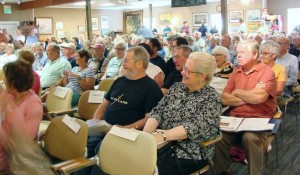
It was standing room only as the sale started. Smith does not use internet bidding, so buyers turn out in person for his sales.
“Yes, they only lasted in their stroller and chair, respectively, sitting peacefully for 30 minutes. Through all the hilarium, I discovered a few good reasons to actually take children to these types of events. My children are learning manners and increasing their attention spans. I did get 30 minutes of quiet, attentive interest and active learning from the proceedings. Possibly because they are required to sit quietly at church for 70 minutes each week, and I take them to non-kid-friendly venues often, I feel like their attention span for adult activities is perhaps longer than it is for other children.” Toler’s take on her day is amusing. Although she did not buy anything at this auction, one might assume that, as available funds increase, she will be a successful bidder. If you scroll down her blog to “Eight Places to Find Vintage & Antiques Pieces for Cheap” you’ll find her shopping hints and photos of her “pieces for cheap.” And by the time you read this, she may have written about her experiences shopping at Brimfield.
All prices reported include the buyer’s premium.
For additional information, www.wsmithauction.com or call 603-675-2549.
[slideshow_deploy id=’1000274613′]

